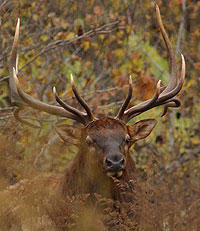As the fog
lifts in the Boxley Valley and the morning sun
kisses the dew on the grass, elk move from the
mottled shade at the edge of the forest into the
open pasture to graze.
Before long, cars are stopped on the side of the
road and their inhabitants stand at the fence row at
the edge of the field, pulling out binoculars and
cameras to view the majestic beasts. It's not
uncommon for the number of wildlife viewers to equal
the number of elk in any |

Arkansas Dept of Parks & Tourism photo |
given herd in Boxley Valley along the Buffalo
National River in the northern Ozarks of Arkansas.
"On the weekends you've got to get here early to get
a spot," said Mike Cartwright, a wildlife biologist
for the Arkansas Game and Fish Commission. "We are
seeing an increase in visitor use to see elk."
One of the most popular places to view elk in their
natural habitat is along Ark. 43 and Ark. 21 in
Boxley Valley. However, elk can often be seen near
the Erbie campground on the south side of the river
or in fields on the north side. Another opportunity
for elk viewing is along roads leading east and west
from Pruitt Bridge in Pruitt. In Carver, look for
elk in the fields near the Carver Bridge and in the
Gene Rush Wildlife Management Area just south of the
river.
Dawn and dusk are the best times to see them and
binoculars are a necessity for an up-close view
since the animals are usually a few yards away.
September through October is mating season for elk
with 76 percent of calves born in early June. At
birth calves weigh about 35 pounds. By the start of
its first winter, the elk may weigh five times as
much as when it was born. By the time they reach
adulthood, cows weigh up to 500 pounds, and bulls
may reach more than 800 pounds, stand five feet at
the shoulder and measure eight feet from nose to
rump. Each year, bulls shed their antlers and it
takes about 180 days for them to grow a new rack.
Elk range through about 315,000 acres in Arkansas in
the northwest part of the state along the Buffalo
National River in Newton and Searcy counties and in
portions of southern Boone and Carroll counties. The
large beasts prefer open areas for grazing with
nearby wooded areas for resting.
Although elk are often thought of as western
animals, the eastern elk was a native of Arkansas.
But, it disappeared from the state's forests
sometime around 1840 and is now considered extinct.
The U.S. Forest Service introduced 11 Rocky Mountain
elk in the Black Mountain Refuge of Franklin County
in 1933. Although the herd did well for a number of
years, it eventually disappeared likely due to
illegal hunting, natural mortality and loss of
suitable habitat. Between 1981 and 1985, 112 Rocky
Mountain elk were again stocked. This time they were
placed near the Buffalo National River in Newton
County.
The 112 elk have grown to about 450 elk. The animals
are referred to as the Hilary Jones Elk Herd, after
former Game and Fish Commissioner Hilary Jones.
Jones, along with local citizens of Newton County,
was instrumental in establishing the elk herd.
Cartwright said local citizens were very supportive
of Jones' program and "that's one reason it's been
very successful."
Another success is the Ponca Elk Education Center,
which is operated by the education division of the
Arkansas Game and Fish Commission. Fifteen thousand
people have visited it in its first two years of
operation. This interpretive center, which has free
admission, contains an exhibit room with full-body
mounts of elk in natural settings as well as an
Arkansas black bear. Hands-on displays include
hides, skulls and other artifacts, a geology
display, interactive computer quizzes, and a birding
window. Groups are welcome to schedule use of the
facility for customized programs.
"People leave with a whole new aspect of Arkansas,"
Phyllis Speer, AGFC regional educational
coordinator, explained. "Many people dont realize
we have elk in Arkansas."
Visitors can shop for educational and fun souvenirs,
books, videos, shirts, and even buy a hunting and
fishing license at the center, which also has rustic
log rockers and benches on its wrap-around deck
overlooking Ponca Creek, picnic tables, and a
covered pavilion. For more information, phone (870)
861-2432.
Another source of information is the Hilary Jones
Wildlife Museum and Elk Information Center in
Jasper. Learn more about elk and other wildlife
through exhibits and video presentations. Exhibits
include elk mounts, three freshwater fish aquariums,
whitetail deer section, duck section, plus wildlife
carvings and paintings. The center contains river
maps, brochures on things to do in Newton County,
wildlife information, and hunting and fishing
licenses. The center is kid-friendly with its large
aquariums, and touch table of furs, feathers and
bones.
The gift shop offers hand-painted agate nightlights,
carved wooden toys, wildlife prints, note cards,
T-shirts, caps, jewelry made from elk antlers,
coffee-cups and more. Admission is free and the
center is located on Scenic Byway 7 about a half
mile north of Jasper and the Little Buffalo River.
For more information, phone (870) 446-6180.
|